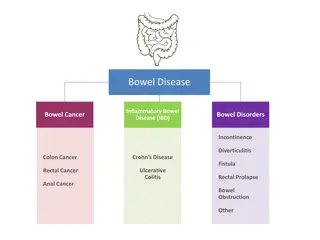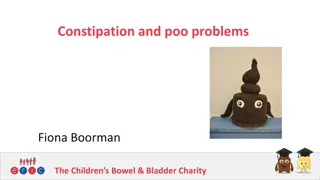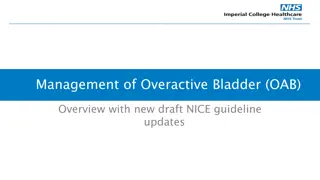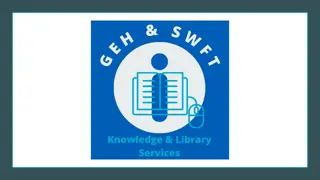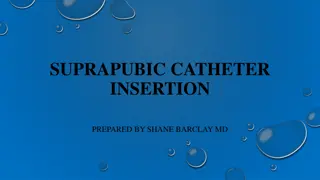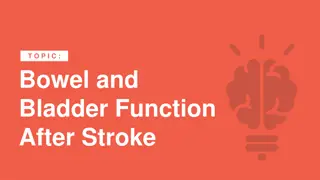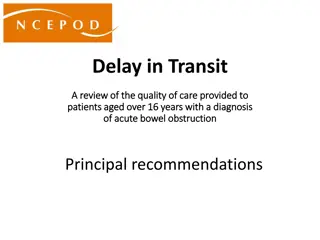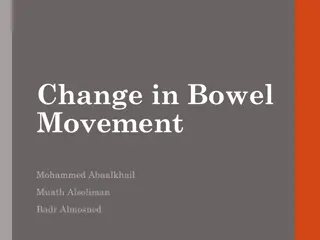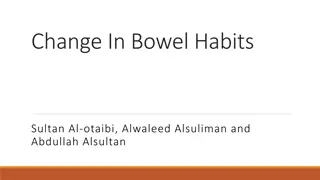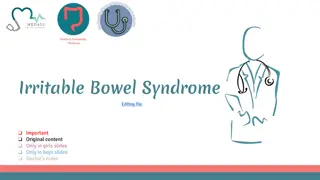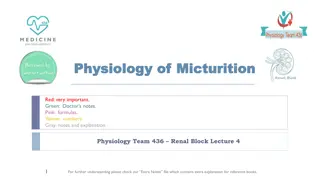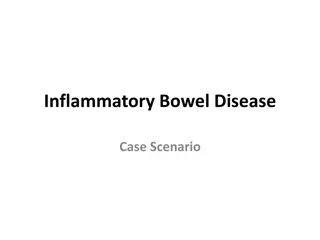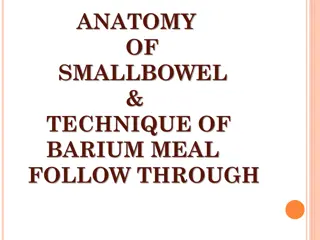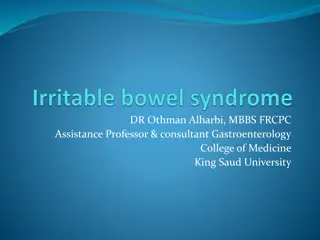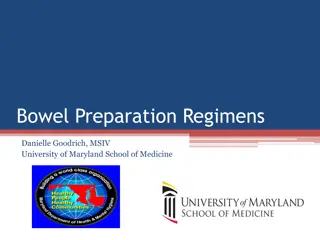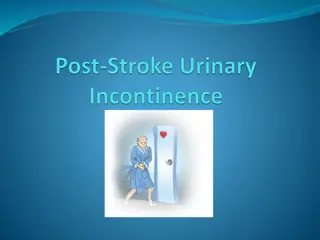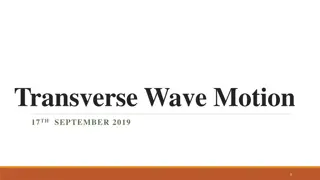Bowel and Bladder Management Post Transverse Myelitis
Following transverse myelitis, there can be significant changes in bowel and bladder function, impacting storage, release, and coordination. Neurogenic bowel and bladder issues, differentiated by injury level, can lead to challenges in controlling sphincters and bathroom habits. Understanding these changes is crucial for proper management and care.
Download Presentation

Please find below an Image/Link to download the presentation.
The content on the website is provided AS IS for your information and personal use only. It may not be sold, licensed, or shared on other websites without obtaining consent from the author. Download presentation by click this link. If you encounter any issues during the download, it is possible that the publisher has removed the file from their server.
E N D
Presentation Transcript
Bowel and Bladder Management Following Transverse Myelitis Janet Dean, MS, RN, CRRN, CRNP Pediatric Nurse Practitioner International Center for Spinal Cord Injury Department of Physical Medicine and Rehabilitation Johns Hopkins Hospital
Bowel and Bladder Functions Store waste Release waste at the appropriate times Each system has Muscular storage area Outlet valve or sphincter Control Voluntary Involuntary
Bladder Function Storage area Bladder or detrusor Outlet valve External urinary sphincter Bladder distends Nerves send signals to cord Signals travel up to brain Brain decides what to do Sends signals down cord Store or release
Bowel Function Storage area Rectum Outlet valve External anal sphincter Rectal distension Triggers urge to defecate Triggers holding reflex Nerves send signals to Cord Signals travel to the brain Brain decides what to do Sends signals down the cord Hold or release
Neurogenic Bowel and Bladder Transverse Myelitis Changes in your bladder and bowel functioning Disrupts sensation of having to urinate or have a bowel movement Disrupt the coordination between the brain and the bowel or bladder Voluntary control of sphincters is lost Changes how you go to the bathroom
Neurogenic Bowel and Bladder Lower Level of injury (T12 and below) Flaccid or areflexic neurogenic Bladder Bladder will not contract when it becomes full Urinary sphincter is loose and fails to contract Difficulty storing urine Bowel Rectum holds stool Anal sphincter fails to contract Difficulty holding stool Higher level of Injury (T12 and above ) Spastic or reflexic neurogenic Bladder Bladder is spastic and irritable Urinary sphincter is tight and does not relax voluntarily Difficulty storing and releasing urine Bowel Decreased GI motility Rectum holds stool Anal sphincter tight and does not relax voluntarily Difficulty releasing stool
Spastic Reflexic Spastic Bladder Problems Bladder tries to distend Bladder spasms Urgency Frequency Incontinence Bladder sphincter dyssynergia Difficulty initiating and maintaining a stream of urine Vesicoureteral reflux Kidney damage Spastic Bowel Problems Rectal distension Anal sphincter tightens Unable to release stool Constipation Impaction
Flaccid-Areflexic Flaccid Bladder Problems Bladder very relaxed Does not contract - overfills Sphincter outlet fails Incontinence Urine leaks out Cough Sneeze or Activities that contract abdominal muscles Flaccid Bowel Problems Rectum dilates Outlet sphincter fails Incontinence Stool leaks out Cough Sneeze Activities that contract abdominal muscles
How do I know Which Type I have? Bladder Urology evaluation Urodynamic or Cystometric studies. VCUG voiding cystourethrogram Renal Ultrasound Bowel Rectal exam Sensation Voluntary contraction Other GI exams are usually not necessary Without Formal Evaluation Level of Injury Lower extremity muscle tone
How to Manage Bowel and Bladder Healthy Habits Healthy diet Drink, Drink, Drink spread fluids out over the day Fiber help with stool constituency Activity Good hygiene Do it yourself Assistive devices Positing equipment Direct own care Establish a good routine
Bowel and Bladder Programs Goals Prevent incontinence and accidents Empty bowel and bladder at predictable times Maintain health and prevent complications Impaction Constipation Diarrhea Thick inelastic bladder Frequent urinary tract infections Kidney damage
Bladder Management Spastic Frequent and urgent urination Medications to relax the bladder Oxybutinin Intermittent Catheterization Every 4 hours (5x/day) Flaccid Leaking of urine Medications not effective Intermittent catheterization Every 3-4 hours Prior to doing activities that cause valsalva
Other Options for Bladder Management Men - Condom catheter overflow Indwelling Foley catheter Not recommended Suprapubic tube Reversible minor surgery Increased UTI and bladder bancer Catheterizable stoma placed in belly button Permanent, major surgery less UTI and less bladder Cancer
Bowel Management Spastic Urgency and frequency May get to the toilet but have difficulty releasing stool Valsalva or contraction of the abdominal muscles pushing against an closed sphincter Flaccid Rectal sphincter will not hold stool Frequent leaking of small amounts of stool Activities that cause valsalva will cause leaking of stool
Bowel Management Bowel Program Takes planning and routine Best done every day to every other day Adults in AM Kids in PM Should take 15 minutes to 1 hour Same time (after meal or snack is ideal) Generally a combination Medications Manual disimpaction Digital stimulation Work with you health professionals Guidelines and advice Customize what works for you
Bowel Management Manage stool consistency Diet Fiber (or supplement) Fluid Medications to soften stool Docusate Sodium PEG (lower doses) Promote GI motility Senna PEG (higher doses)
Bowel Management Positioning Sit up on the toilet or bedside commode Lay on left side if you can not sit up Children Be sure feet are supported on a foot stool and they are comfortable
Bowel Management Manual disimpaction Using a gloved, well lubricated finger inserted into the rectum to break up and gently remove stool Remove stool that will be in the way Digital stimulation Inserting a gloved, well lubricated finger into the anal sphincter and gently rotating the finger around the anal sphincter in a circular direction Trigger reflex evacuation Rectal Medication Bisacodyl suppository, Magic Bullet suppository. Enemeez mini enema Trigger reflex evacuation
Bowel Program Spastic Routine Bowel Program Every 1-3 days Soft formed stool Trigger reflex evacuation Digital stimulation Suppository Flaccid Routine Bowel Program 1-2 x/day Firm formed stool Easy to remove but does not leak Suppositories generally do not work Manual disimpaction 1-2 times per day prior to activities that cause valsalva
Bowel Program Spastic Bowel Manually remove stool from rectum Insert suppository Digital Stimulation after 5- 15 minutes Continue digital stimulation every 5-10 minutes 3-4 times Flaccid Bowel Manually remove stool from rectum. Can try digital stimulation Valsalva or bearing down push ups, abdominal massage Use caution can cause hemorrhoids
How do I Know Program is Complete? Spastic No stool in rectal vault after 2 digital stimulations 10 apart Mucus and no stool Rectal sphincter becomes tight Flaccid Rectal vault is empty
Other Options for Bowel Management Flaccid Bowel Cecostomy - reversible ACE procedure - permanent Allows you to do an enema from above Spastic Bowel Be cautions of above procedure with spastic rectal sphincter
Resources http://www.pva.org/site/PageServer?pagename=pubs_main


